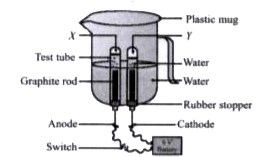Complete Solutions to EXERCISE (MULTIPLE CHOICE QUESTIONS) (LEVEL-2) of chapter CHEMICAL REACTIONS AND EQUATIONS of Class 10 book with complete answers and questions
| Class 10 | CHEMISTRY |
| Chapter | CHEMICAL REACTIONS AND EQUATIONS |
| MTG IIT JEE FOUNDATION | EXERCISE (MULTIPLE CHOICE QUESTIONS) (LEVEL-2) |
| Number Of Questions | 20 |
| Academic Year | 2023-24 |
A dilute ferrous sulphate solution was gradually added to the beaker containing acidified permanganate solution. The light purple colour of the solution fades and finally disappears. Which of the following is the correct explanation for the observation?
View SolutionA dilute solution of sodium carbonate was added to two test tubes - one containing dil. HCl (A) and the other containing dilute NaOH (B). The correct observation was
View SolutionWhich of the following species do not show disproportionation reaction ?
View SolutionIn the reaction, `H_(2)S+H_(2)O_(2)toS+2H_(2)O`
View SolutionWhich of the following is true regarding dissolution of `NH_(4)Cl` in water?
View SolutionIn which of the following chemical equations, the abbreviations represent the correct states of the reactants and products involved at reaction temperature?
View SolutionIn the ionic equation,
`BiO_(3)^(-)+6H^(+)+xe^(-) to Bi^(3)+3H_(2)O`, the value of x is
View SolutionWhich of the following shows the given reactions in the increasing order of speed of the reaction?
(i) `2KClO_(3(s))overset(Delta)to2KCl_((s))+3O_(2(g))`
(ii) `2KClO_(3(s))underset(MnO_(2))overset(Delta)to2KCl_((s))+3O_(2(g))`
(iii) `6CO_(2(g))+6H_(2)O_(l)overset("Sunlight")underset("Chlorophyll")toC_(6)H_(12)O_(6(aq))+6O_(2(g))`
View SolutionWhich of the following is a redox reaction?
View SolutionGiven `E_("Cr_(2)O_(7)^(2-)//Cr^(3+))^(@)=1.33V,E_(MnO_(4)^(-)//Mn^(2+))^(@)=1.51V`
Among the following, the strongest reducing agent is `E_(Cr^(3+)//Cr)^(@)=-0.74V^(x),E_(MnO_(4)^(-)//Mn^(2+))^(@)=1.51V`
`E_(Cr_(2)O_(7)^(2-)//Cr^(3+))^(@)=1.33V,E_(Cl//Cl^(-))^(@)=1.36V`
Based on the data given above strongest oxidising agent will be
View SolutionWhich of the following reactions evolves heat?
View SolutionWhich of the following is not a thermal decomposition reaction?
View SolutionWhich of the following combination of reactants will lead to the formation of reddish brown precipitate?
View SolutionThree beakers labelled as A, B and C each containing 25 mL of water were taken. A small amount of NaOH, anhydrous `CuSO_(4)` and NaCl were added to the beakers A, B and C respectively. It was observed that there was an increase in the temperature of the solutions contained in beakers A and B, whereas in case of beaker C, the temperature of the solution falls. Which one of the followig statement (s) is (are) correct?
1. In beakers A and B, exothermic process has occurred.
2. In beakers A and B, endothermic process has occurred.
3. In beaker C, exothermic process has occurred.
4. In beaker C, endothermic process has occurred.
View SolutionWhen the ion `Cr_(2)O_(7)^(2-)` acts as an oxidant in acidic aqueous solution the ion `Cr^(3+)` is formed. How many mole of `Sn^(2+)` would be oxidised to `Sn^(4+)` by one mole `Cr_(2)O_(7)^(2-)` ion:
View SolutionWhich is a double displacement as well as neutralisation reaction?
View SolutionWhich of the following processes does not involve either oxidation or reduction?
View SolutionWhen sodium hydroxide is added to ferric chloride solution, a reddish brown precipitate is formed. The precipitate is separated from the mixture by the process of ________.
View SolutionComplete the chemical reaction.
`Mg_((s))+H_(2)SO_(4(aq))to?`
View SolutionStudy the given diagram carefully.

Identify X, Y and the type of reaction occurring.
View Solution
EXERCISE (MULTIPLE CHOICE QUESTIONS) (LEVEL-2) questions and complete solutions for chapter CHEMICAL REACTIONS AND EQUATIONS of MTG IIT JEE FOUNDATION of Class 10
All Exercises from MTG IIT JEE FOUNDATION Class 10 CHEMISTRY CHEMICAL REACTIONS AND EQUATIONS
- EXERCISE (ASSERTION & REASON TYPE)
- EXERCISE (COMPREHENSION TYPE)
- EXERCISE (INTEGER/NUMERICAL VALUE TYPE)
- EXERCISE (LONG ANSWER TYPE)
- EXERCISE (MATCH THE FOLLOWING)
- EXERCISE (MULTIPLE CHOICE QUESTIONS) (LEVEL-1)
- EXERCISE (MULTIPLE CHOICE QUESTIONS) (LEVEL-2)
- EXERCISE (SHORT ANSWER TYPE)
- EXERCISE (VERY SHORT ANSWER TYPE)
- ILLUSTRATIONS
- NCERT SECTION
- OLYMPIAD/HOTS CORNER
- SOLVED EXAMPLES